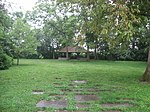Mariemont Historic District
Historic districts in Hamilton County, OhioHistoric districts on the National Register of Historic Places in OhioNRHP infobox with nocatNational Historic Landmarks in OhioNational Register of Historic Places in Hamilton County, Ohio ... and 1 more
Use mdy dates from August 2023

The Mariemont Historic District is a National Historic Landmark District encompassing most of the municipality of Mariemont, Ohio, USA. Mariemont was planned and developed in the 1920s by philanthropist Mary Emery and landscape architect John Nolen, and was one of the nation's first planned suburban communities. Its architecture and streetscape are still strongly evocative of its original plans. A large portion of the community was listed on the National Register of Historic Places in 1979; a larger area (fully encompassing the first listing) was designated a National Historic Landmark (as Village of Mariemont) in 2007.
Excerpt from the Wikipedia article Mariemont Historic District (License: CC BY-SA 3.0, Authors, Images).Mariemont Historic District
Wooster Pike,
Geographical coordinates (GPS) Address Nearby Places Show on map
Geographical coordinates (GPS)
| Latitude | Longitude |
|---|---|
| N 39.145 ° | E -84.373611111111 ° |
Address
Mariemont Historic District
Wooster Pike
45227
Ohio, United States
Open on Google Maps






